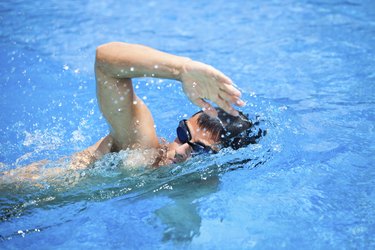
There are four different common swimming strokes, including the freestyle, butterfly, backstroke and breaststroke. Though they have some similarities, knowing the difference between each can help improve your overall swimming.
Erin Oliphant, USAT certified triathlon coach and current swim coach at Life Time, recommends learning the basics of all four strokes to keep your swim sessions engaging and well-rounded.
Video of the Day
Video of the Day
"Knowing more strokes than just freestyle allows for more variety in your workouts, which can help swimmers find joy and longevity in the sport," Oliphant says. "Doing other strokes aside from freestyle helps to create muscle balance and reduces the likelihood of overuse injuries from doing just one stroke."
Learn the four different swimming styles and try a few different techniques during your next pool or ocean swim workout.
1. Freestyle
The classic freestyle, formally known as the front crawl, combines a scissor kick with alternating arms. The arm stroke starts overhead and finishes against your side, fingers pointing toward your legs. You face the bottom of the pool to swim the freestyle.
The international swimming governing body, the Federation Internationale de Natation (FINA) doesn't set out specific rules for swimming the freestyle. Swimmers can swim any style they chose during freestyle events. However, during medleys events, freestyle can not be performed as a backstroke, breaststroke or butterfly.
Nevertheless, most swimmers perform the classic front crawl (described above), as it is the fastest stroke when performed correctly — even faster than the butterfly, according to Oliphant.
"Freestyle allows you to have constant propulsion through the water," Oliphant says. "Secondly, there is very little drag created during the freestyle stroke when the body is in a straight line with hips and legs held in line with the chest. This straight line limits the amount of water tension the body must move through to proceed forward."
Freestyle is a moderately challenging stroke to learn for most swimmers. Oftentimes, it can be challenging to learn to breathe on the side during freestyle, as it requires a lot of coordination between your core, arms, and timing of the stroke.
However, with practice and maybe even some beginner lessons, freestyle is totally attainable for adults and children.
2. Butterfly
The butterfly stroke combines an underwater dolphin kick with an overhead arm pull to your legs, while you move your arms simultaneously. To do this stroke properly, you move your legs up and down simultaneously without performing a scissor kick or breaststroke kick (where the legs kick outward and away from the hips), according to the FINA.
Butterfly, when done correctly, is the second-fastest swimming stroke after freestyle swimming. That's because your arms move together to create max pull through the water at once, and your legs kick together in a dolphin kick, generating lots of propulsion.
"It can be argued that underwater kicking is even faster than freestyle," Oliphant says. "When done correctly, underwater dolphin kicks, like in butterfly, create a massive amount of propulsion because this kick does not break the surface tension of the water, meaning there is no above-water drag created by this kick."
Despite being the second-fastest swimming stroke after front crawl, butterfly is not an easy swimming technique to learn. This stroke requires a lot of strength, especially in your core and lower back. Moving your arms forward and down while dolphin kicking also requires a lot of coordination.
3. Backstroke
Backstroke is the third-fastest - or second-slowest - swimming stroke. In backstroke, you float on your back with your face out of the water, performing a scissor kick. Your arms alternate, starting overhead (like in a freestyle), pulling behind you through the water, down to your legs.
Freestyle and backstroke are often compared to each other as they are nearly the same stroke, except in freestyle, you stay on your front and in backstroke, you swim on your back. Despite these similarities, freestyle swimming is still the faster of the two.
"The reason freestyle swimming is faster than backstroke swimming is because the position of your arm in front crawl stroke allows you to use stronger muscles in your back and sides to propel you forward," Oliphant says. "Additionally, there is slightly less drag created during the freestyle stroke than the backstroke."
The backstroke isn't too challenging to learn, especially if you're already familiar with the front crawl. It also eliminates the need to rotate and breathe, so, for some swimmers, it may feel even easier than the freestyle.
It can feel a little disorienting to look up at the sky or ceiling, rather than the bottom of the pool. Luckily, most pools have flags at the 5-meter line to let you know you're nearing the wall.
4. Breaststroke
The breaststroke is the slowest of all four strokes and combines different swimming techniques. In the breaststroke, you scoop the water around you with both arms, creating like a heart shape. Then, you shoot your palms forward, fingers pointing forward, away from your chest. At the same time, your legs kick out like a frog and back into a straight line.
"Breaststroke is by far the slowest stroke," Oliphant explains. During this stroke, your body creates a lot of drag and resistance, reducing speed in the water. That's why this one is often used as a recovery stroke.
Although breaststroke requires the longest swim time, it's also one of the easiest and most intuitive to learn. This is because most people want to lift their head to breathe, which is the natural way to breathe during this stroke.
While kicking your legs outward may not be speedy, it is an easy and gentle motion to learn for all ages, and does not require the swimmer to kick their legs out of the water or in a rapid motion as in freestyle or backstroke.